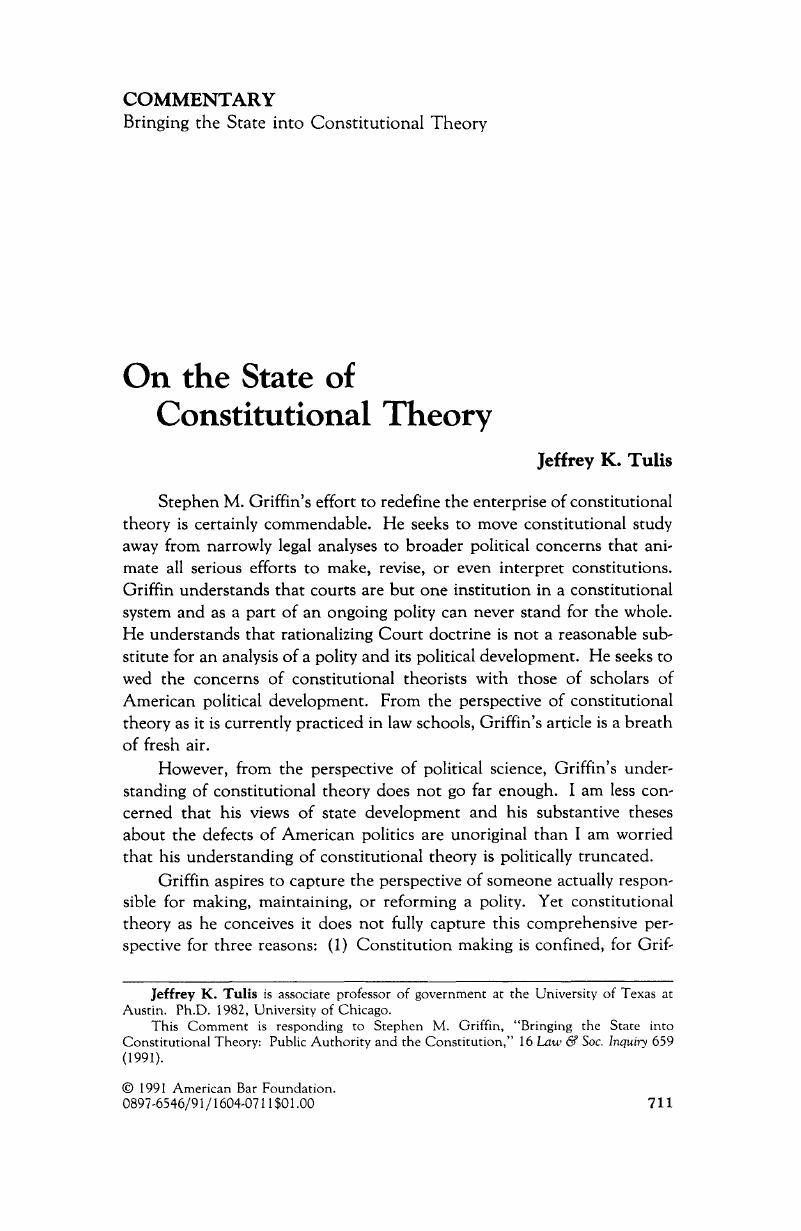Article contents
On the State of Constitutional Theory
Published online by Cambridge University Press: 27 December 2018
Abstract

- Type
- Articles
- Information
- Copyright
- Copyright © American Bar Foundation, 1991
References
1 Jeffrey K. Tulis, “The Constitutional Presidency in American Political Development,” in Martin L. Fausold & Alan Shank eds., The Constitution and the American Presidency 133–47 (Albany: State University of New York Press, 1991). Compare Theodore Lowi, The Personal President (Ithaca, N.Y.: Cornell University Press, 1985), and Bruce Ackerman, We the People (Cambridge, Mass.: Harvard University Press, 1991).Google Scholar
2 I do not wish to imply, of course, that a constitutional analysis is sufficient to explain the timing or precise character of later developments such as the New Deal. For that purpose one can do no better than the “new institutionalism.” But a constitutional analysis is necessary, I think, to locate the deep-structure of New Deal liberalism in American politics.Google Scholar
3 Griffin relies solely on The Federalist's first statement in No. 8. But see especially the more elaborate second statement, Nos. 25, 26, and 41. Gestures to contemporaneous public opinion followed by more honest accounts of the implications of the Constitution are characteristic of the rhetorical structure of the entire Federalist papers.Google Scholar
4 Martin Van Buren, The Origin and Course of Political Parties in the United States (New York: Hurd & Houghton, 1867). See also James W. Ceaser, Presidential Selection: Theory and Development (Princeton, N.J.: Princeton University Press, 1979).Google Scholar
5 If we were to quarrel, it would be to point out that the test of practicality invoked by Griffin could be satisfied by showing some norm to be potentially actual. I assume his own suggested reforms have this character.Google Scholar
6 See Taylor, Charles, “Interpretation and the Sciences of Man,” 25 Rev. Metaphysics 1 (1971).Google Scholar
7 For the best critique of a constitutional theorist's attempt to dispense with normative inquiry, see Sotirios A. Barber, “Normative Theory, the ‘New Institutionalism,’ and the Future of Public Law,” 2 Stud. Am. Pol. Devel. 56–73 (Yale University Press, 1989).CrossRefGoogle Scholar
8 For a useful summary of this debate, see Robert A. Goldwin & Art Kaufman, eds., Separation of Powers—Does It Still Work? (Washington, D.C.: AEI Press, 1986). On the importance of comparisons, one cannot help but wonder whether use of the term “crisis” is strained by Griffin, given the recent crises in Eastern Europe and the Soviet Union.Google Scholar
9 Sheldon S. Wolin, The Presence of the Past: Essays on the State and the Constitution (Baltimore: Johns Hopkins University Press, 1989); Harris, William F., “Bonding Word and Polity: The Logic of American Constitutionalism,” 76 Am. Pol. Sci. Rev. 34 (March 1982); Sotirios A. Barber, On What the Constitution Means (Baltimore: Johns Hopkins University Press, 1984); Harvey C. Mansfield, Jr., America's Constitutional Soul (Baltimore: Johns Hopkins University Press, 1991).Google Scholar
- 3
- Cited by




